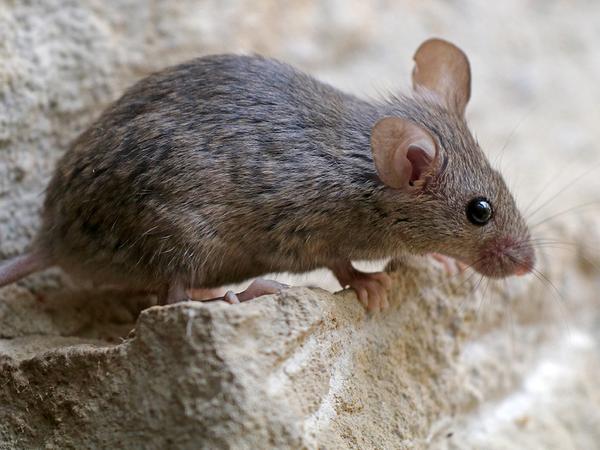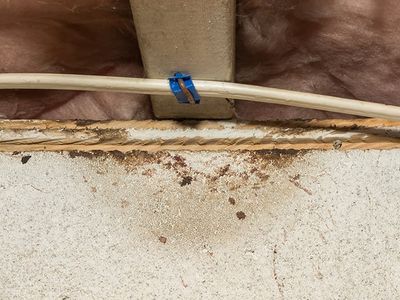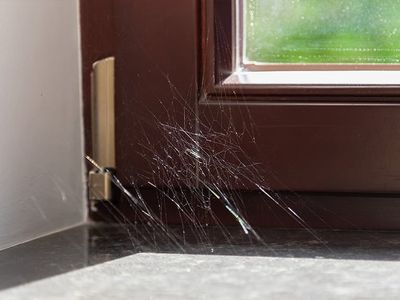What do mice look like?
The most common house mouse in Arizona is Mus musculus, often referred to as the house mouse. It is 2 ½ to 3 ¾ inches long, dusty gray, with a cream belly. It has the features of a mouse: black eyes, perky ears, a conical snout, and a long, thin tail that is the same length as its head and body combined.

What do mice eat?
Mice are omnivores with a surprisingly diverse diet. They feed on seeds, leaves, roots, the stems of plants, and a variety of insects. When they get into structures, they survive on crumbs. They'll eat bread, cereal, seeds, nuts, and more.
Why do mice squeak or make noises?
Mice communicate with each other through vocalizations and often squeak to maintain social bonds. Male mice produce a complex and ultrasonic song in response to female pheromones. Both male and female mice may also make noises inside walls. You might hear bumping, scratching, or gnawing.
When are mice most active?
A house mouse has poor eyesight and functions better in low light conditions due to its other heightened senses. Mice use their hearing for echolocation, smells as a map of their environment, and touch to feel their way through complex environments. House mice also prefer low-light conditions because these conditions provide concealment. For these reasons, mice prefer nocturnal activity, but they're more than capable of daytime activity if they live inside a structure and find dark places to explore for food.
Where do mice build their nests?
Mice collect soft materials, such as foam, paper, insulation, and fabrics, to build their nests. They ball these materials up and pack them into tight spaces. You may find a soft, balled-up nest inside the drawer of a piece of furniture in storage, or within a gap in a wall. You may find mice nesting above a drop-down ceiling, or some other secluded space. You'll also find mice making their nests close to food. A wall of a pantry is an ideal location.
When do mice breed?
House mice breed all year long. A typical female can have 5 to 10 litters annually. A litter can contain as many as 12 pups, but typically have only 6 to 8. These pups grow to sexual maturity in 4 to 7 weeks, depending on the conditions present. Once mature, an impregnated female mouse can give birth in around 20 days. As you can see, mice can reproduce incredibly fast.
Are mice dangerous?
Yes. There are many ways mice present a danger inside man-made structures. Some are sure to surprise you.
- Mice get into garbage and pick up disease-causing bacteria.
- Mice carry ticks and fleas, which are known sources of disease propagation.
- Mice chew holes that can allow other pests into structures such as scorpions.
- Mice chew on wires and are considered a significant fire hazard.
- Mice leave their droppings in many places, and their waste is a contaminant.
- Mice contaminate and damage insulation and stored items.
It is best to quickly address a mouse infestation when you detect any signs of activity. It doesn't take long for a small problem to grow.
How do mice get into houses?
A mouse can fit through a gap the size of a dime. If it finds a smaller hole, it can make it larger by using its strong teeth. These animals most commonly enter homes when they detect holes because they perceive a hiding or nesting location on the other side. Gaps in weatherproofing materials, wood damage, and structural gaps are the most common entry points for these pests.
How do I get rid of mice?
Mouse control is a challenge. While they are curious animals that sometimes fall victim to traps, it is rare to easily trap and remove all of the mice in a structure. They have natural behavior patterns and abilities that help them avoid traps. Along with this, they commonly reproduce faster than property owners can collect them for removal. Mouse control requires a multi-pronged strategy of inspections, trapping, baiting, surveillance, exclusions, and more. Contact Greenway Pest Solutions for an effective rodent treatment.
How can I keep mice out?
There are three ways you can keep mice out of your home: removal of attractants, application of rodent proofing, and structural alteration.
- Remove food sources, hiding places, and moisture.
- Use weatherproofing materials, a caulking gun, a can of expanding foam, and hardware cloth to keep rodents out.
- Trim branches away from your roof, cover downspouts with wire mesh, and install rodent guards to stop rodents from scaling pipes or running across power lines to get onto your roof.
For more control, consider a year-round pest control service plan for ongoing rodent management.








